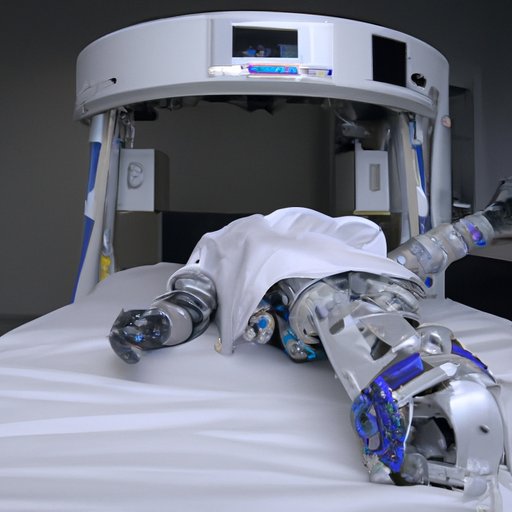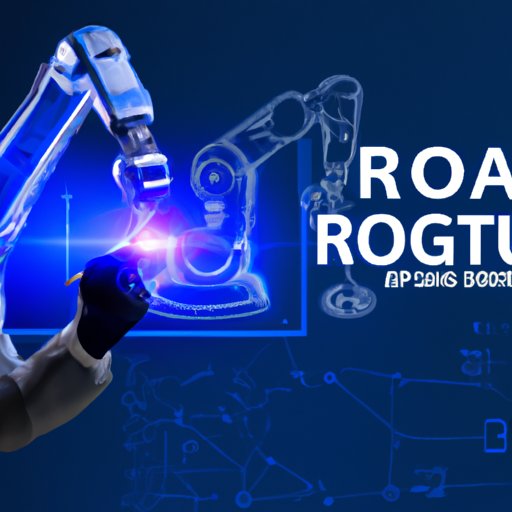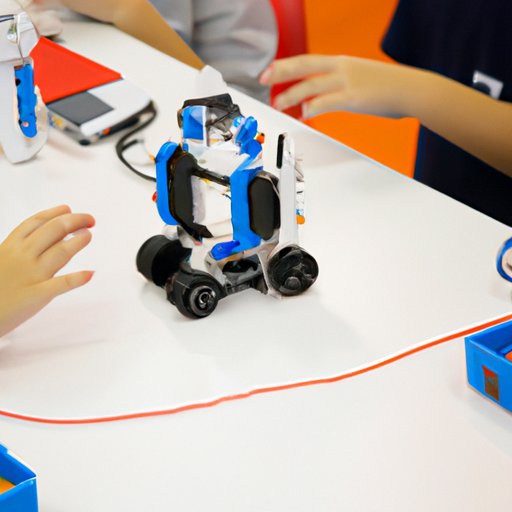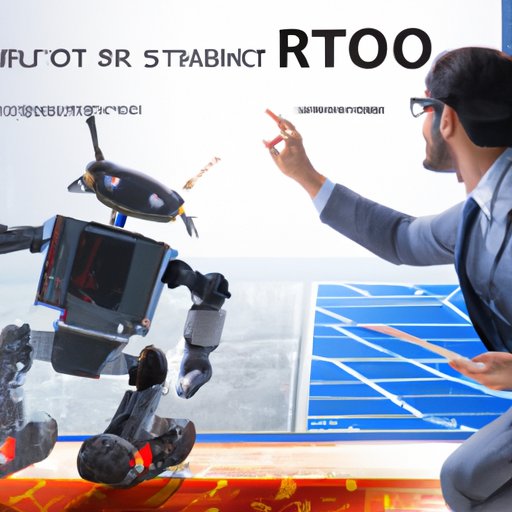Introduction
Robots are machines that are programmed to carry out a particular task or set of tasks with accuracy and speed. They are often used in industrial settings for repetitive tasks, but their applications have expanded to include service robots, autonomous robots, and even robots for healthcare, education, and space exploration. In this article, we’ll explore the different types of robots and what they are used for.
Exploring the Different Types of Robots and What They Are Used For
Robots come in many shapes and sizes, and they can be used for a variety of applications. Here are some of the most common types of robots and what they are used for:
Industrial Robots
Industrial robots are typically used for factory automation and are designed to perform highly precise and repetitive tasks. These robots are often used in manufacturing, assembly, and packaging operations. According to a study by the International Federation of Robotics, industrial robots are expected to account for 40% of all robot installations globally by 2020.
Service Robots
Service robots are designed to assist humans with daily tasks. These robots can be used for a variety of purposes, such as vacuuming, lawn mowing, and window cleaning. Service robots are becoming increasingly popular in the home, with sales estimated to reach 3.3 million units in 2019, according to research firm Tractica.
Autonomous Robots
Autonomous robots are designed to operate without human intervention. These robots are often used in hazardous environments, such as military operations or deep-sea exploration, where it’s too dangerous for humans to go. Autonomous robots are also being used in warehouses and factories to automate processes and increase efficiency.
Examining How Robots Are Being Used in the Workforce
Robots are increasingly being used in the workforce to automate processes, reduce costs, and increase efficiency. Here are a few examples of how robots are being used in the workplace:
Manufacturing
Robots are used extensively in manufacturing to automate processes and reduce labor costs. According to a report from the World Robotics Organisation, industrial robots are now used in almost every industry, from automotive to electronics. This has resulted in increased productivity and improved product quality.
Construction
Robots are being used in the construction industry to improve safety and efficiency. Autonomous robots are being used to lift heavy materials and move them around construction sites. Some robots are even being used to build structures, such as bridges and buildings.
Healthcare
Robots are being used in healthcare to assist doctors and nurses with a variety of tasks, such as surgery, diagnosis, and pharmacy. Robotic surgeries are becoming increasingly popular due to their accuracy and precision. According to a study by the American Association for the Advancement of Science, robotic surgeries will become the norm by 2025.

A Look at How Robots Are Used in Medicine
Robots are being used in a variety of ways in the medical field, from surgery to diagnostics. Here are some of the most common uses of robots in medicine:
Surgical Robots
Robotic surgery is becoming increasingly popular due to its accuracy and precision. Robotic surgical systems allow surgeons to perform complex procedures with more accuracy than traditional methods. According to a study by the National Institutes of Health, robotic surgery has been found to reduce the risk of complications and improve patient outcomes.
Diagnostic Robots
Robots are being used to diagnose diseases with greater accuracy than ever before. Artificial intelligence (AI) is being used to analyze medical images, such as X-rays and CT scans, to detect anomalies and diagnose diseases. According to a study by the University of California San Diego, AI-powered diagnostic robots can accurately detect cancerous tumors with 95% accuracy.
Pharmacy Robots
Robots are being used to automate the process of dispensing medication in hospitals and pharmacies. These robots are able to accurately dispense medication with greater speed and accuracy than manual methods. According to a study by the Institute for Safe Medication Practices, robotic pharmacy systems have been found to reduce medication errors by up to 70%.

Analyzing the Impact of Robotics on Manufacturing
Robotics is having a major impact on the manufacturing industry, from automating processes to increasing efficiency. Here are some of the ways that robotics is impacting manufacturing:
Automation of Processes
Robots are being used to automate processes in the manufacturing industry, from welding and painting to assembly and packaging. This has resulted in increased production speeds and improved product quality. According to a study by the International Federation of Robotics, robots are now used in almost every industry, from automotive to electronics.
Increased Efficiency
Robots are able to work faster and more efficiently than humans, resulting in increased productivity. According to a study by the World Robotics Organisation, industrial robots are now used in almost every industry, from automotive to electronics. This has resulted in increased production speeds and improved product quality.
Reduced Costs
Robots require less maintenance than humans and can operate 24 hours a day, seven days a week. This has resulted in reduced labor costs and improved profitability. According to a study by the International Federation of Robotics, robots are now used in almost every industry, from automotive to electronics. This has resulted in increased production speeds and improved product quality.

Investigating the Use of Robots in Education
Robots are being used in education to engage students and teach them new skills. Here are some of the ways that robots are being used in education:
Tutoring Robots
Robots are being used to tutor students in a variety of subjects, from math and science to language and history. These robots use artificial intelligence (AI) to assess a student’s knowledge and adjust the lesson accordingly. According to a study by the Massachusetts Institute of Technology, AI-powered tutoring robots can help students learn faster and more effectively than traditional methods.
Robotics Courses
Robotics courses are becoming increasingly popular in schools and universities. These courses teach students how to design, build, and program robots. According to a study by the National Science Foundation, robotics courses can help students develop problem-solving skills, critical thinking skills, and an understanding of engineering principles.
Assistive Robots
Robots are being used to assist students with disabilities. These robots can help students with physical impairments, such as mobility issues, or cognitive impairments, such as autism. According to a study by the U.S. Department of Education, assistive robots can help students with disabilities learn and interact more effectively with their peers.

Analyzing the Use of Robots in Space Exploration
Robots are being used extensively in space exploration to explore distant planets and asteroids, collect data, and repair satellites. Here are some of the ways that robots are being used in space exploration:
Robotic Probes
Robotic probes are being used to explore distant planets and asteroids. These probes are equipped with cameras and instruments to take pictures and collect data. According to a study by NASA, robotic probes have been used to explore Mars, Venus, and other planets in our solar system.
Astronaut Assistance
Robots are being used to assist astronauts in conducting experiments and making repairs in space. These robots are equipped with sensors and cameras to provide assistance to astronauts. According to a study by the European Space Agency, robotic assistants have been used to help astronauts conduct experiments and make repairs in space.
Space Debris Removal
Robots are being used to remove debris from Earth’s orbit. These robots are equipped with sensors and manipulators to identify and capture debris. According to a study by the Japan Aerospace Exploration Agency, robotic debris removal systems have been used to clear up to 10,000 pieces of space debris from Earth’s orbit.
Exploring the Potential Uses of Robots in the Future
Robots are becoming increasingly sophisticated and are being used in a variety of applications. Here are some of the potential uses of robots in the future:
Artificial Intelligence
Robots are being used to develop artificial intelligence (AI). AI-powered robots are capable of learning and adapting to their environment. According to a study by the University of Oxford, AI-powered robots could be used to automate processes and improve decision-making in a variety of fields, from healthcare to finance.
Autonomous Vehicles
Robots are being used to develop autonomous vehicles. These vehicles are equipped with sensors and cameras to navigate roads and traffic. According to a study by the World Economic Forum, autonomous vehicles could reduce traffic fatalities by up to 90% and improve fuel efficiency by up to 30%.
Domestic Robots
Robots are being used to automate household tasks. These robots can vacuum, mow the lawn, and even clean windows. According to a study by Tractica, domestic robots are expected to become increasingly popular in the home, with sales estimated to reach 3.3 million units in 2019.
Conclusion
Robots are becoming increasingly sophisticated and are being used in a variety of applications, from manufacturing to healthcare. They are used to automate processes, increase efficiency, and reduce costs. They are also being used in education, space exploration, and even the home. As technology advances, robots will become even more advanced and capable of performing more complex tasks. The possibilities are endless.
The benefits of robotic technology are numerous, from increased efficiency and reduced costs to improved safety and enhanced accuracy. As robots continue to evolve, they will become increasingly useful in a variety of industries and applications.
(Note: Is this article not meeting your expectations? Do you have knowledge or insights to share? Unlock new opportunities and expand your reach by joining our authors team. Click Registration to join us and share your expertise with our readers.)
